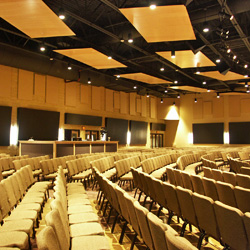
Reflected Sound
It is important to make sure that you strike an acoustical balance between the various applications used to communicate the message.
For example, if a room is too reverberant, reflected sound will interfere with the spoken word – even though music might sound wonderful.
If a room is not reverberant enough, musical factors such as “ensemble” of the performers and “envelopment” of the participants may suffer – even though speech is very well understood.
Controlling reflected sound is the key to making a worship setting sound good. Absorption of sound waves can be accomplished through common room features like curtains, carpet and even the people in the pews.
Diffusion is provided by anything that breaks up a parallel surface and directs sound waves in different directions.
The placement of wall décor like window trim and statuettes are sometimes enough to provide adequate diffusion, depending on the style of worship. While these common room features help control acoustic anomalies, they are typically not enough and acoustical panels are usually needed to properly treat a house of worship.
Absorbers make a room more “dead” acoustically by absorbing and trapping sound energy in high-density fiberglass or other fibers.
Absorption is an important element of speech intelligibility because it reduces the reflected energy that can mask spoken word.
Redirectors interrupt parallel surfaces to prevent reflection. Redirection is often helpful in the choir area to allow the singers to hear themselves and each other.
Redirectors range from angled sheets of painted plywood mounted to the wall to the popular convex half-barrels and pyramidal prefabricated panels.
Diffusors accomplish accurate redirection of sound energy with complex surfaces. These highly engineered surfaces evenly distribute sound and create a sense of warmth or envelopment to the room.
Diffusion can also make a space sound larger and provide the same degree of high-quality sound to every person in the sanctuary. This contributes to eliminating hot spots or nulls.
Specifying the quantity, size and placement of these materials is a science and acoustical professionals should be contacted in order to obtain the best treatment plan for your space.
Stage Resonance and Stage Volume
If your church has a live band, you may have heard this one before. A typical scenario is when the guitar player says that he cannot hear himself, so he turns his volume up.
This is followed by the bass player turning up, the drummer playing louder, and so on. The result is drastically increased stage volume that can compete and interfere with the main sound system.
Also, the audience suffers because the sound from the stage is excessive and can be annoying to some members of the congregation.
A large number of stages are built as hollow cavities. These cavities have a tendency to resonate (similar to a drum) and produce an audible tone. Hollow stages can cause a “muddy” sound where low frequency energy is dominating the room.
This lingering low frequency energy can have a negative impact on speech intelligibility and cause music to seem unbalanced and unpleasant to listen to. Also, the walls and ceiling around the stage area are often neglected when it comes to acoustical treatment and are highly reflective surfaces.
Ways to improve this situation is to fill in the hollow cavity below the stage with standard insulation. Attacking the vibration at the source is also a great option.
There are commercially available products that will “decouple” (similar to the shocks in your car) the vibrations caused by guitar amplifiers, subwoofers, and stage monitors that are directly connected to the stage.
Finally, selecting the proper amount and placement of absorption and diffusion panels for the stage area will also bring down the stage volume, resulting in a more pleasing acoustical environment.
Understanding these common acoustical problems will help you to make decisions for your church that will dramatically improve the experience for your congregation and allow you to effectively deliver the message.
Gavin Haverstick is the owner of Haverstick Designs, a full-service acoustical consulting firm specializing in architectural acoustics.
